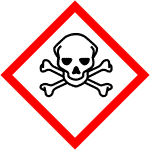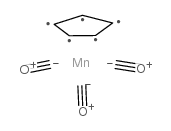三羰基环戊二烯锰(I) ,tricarbonyl(η-cyclopentadienyl)manganese
产品编号:SIGMA-288055| CAS NO:12079-65-1| 分子式:C8H5MnO3| 分子量:204.0615
本网站销售的所有产品仅用于工业应用或者科学研究等非医疗目的,不可用于人类或动物的临床诊断或者治疗,非药用,非食用,
| 产品名称 | 三羰基环戊二烯锰(I) |
|---|---|
| 英文名称 | tricarbonyl(η-cyclopentadienyl)manganese |
| CAS编号 | 12079-65-1 |
| 产品熔点 | 72-76ºC(lit.) |
| 产品沸点 | 41.5ºCat 760 mmHg |
| 精确质量 | 203.96200 |
| LogP | 0.39750 |
| 外观性状 | 黄色晶体或结晶大块 |
| 溶解性 | Soluble in water (70 ppm (25C) |
| 稳定性 | 常温常压下稳定 避免的物料 氧化物 |
| 储存条件 | 常温密闭避光,通风干燥处 |
相关文档
化学品安全说明书(MSDS)
下载MSDS质检证书(COA)
相关产品
| 符号 |

GHS06 |
|---|---|
| 信号词 | Danger |
| 危害声明 | H300 |
| 警示性声明 | P264-P301 + P310 |
| 个人防护装备 | Eyeshields;Faceshields;full-face particle respirator type N100 (US);Gloves;respirator cartridge type N100 (US);type P1 (EN143) respirator filter;type P3 (EN 143) respirator cartridges |
| 危害码 (欧洲) | T+ |
| 风险声明 (欧洲) | R28 |
| 安全声明 (欧洲) | 28-36/37-45 |
| 危险品运输编码 | UN 2811 6.1/PG 2 |
| WGK德国 | 3 |
| RTECS号 | OO9720000 |
| 包装等级 | II |
| 危险类别 | 6.1 |
Synonym:Cymantren Section 2 - COMPOSITION, INFORMATION ON INGREDIENTS
Risk Phrases: 26/27/28 Section 3 - HAZARDS IDENTIFICATION EMERGENCY OVERVIEW
Very toxic by inhalation, in contact with skin and if swallowed.Air sensitive. Potential Health Effects Eye: May cause eye irritation. Skin: May cause skin irritation. Ingestion: May be fatal if swallowed. May cause irritation of the digestive tract. May cause central nervous system depression. Inhalation: May cause respiratory tract irritation. May cause lung damage. Chronic: May cause lung damage. Section 4 - FIRST AID MEASURES Eyes: Flush eyes with plenty of water for at least 15 minutes, occasionally lifting the upper and lower eyelids. Get medical aid. Skin: Get medical aid. Flush skin with plenty of water for at least 15 minutes while removing contaminated clothing and shoes. Wash clothing before reuse. Ingestion: Never give anything by mouth to an unconscious person. Get medical aid. Do NOT induce vomiting. If conscious and alert, rinse mouth and drink 2-4 cupfuls of milk or water. Wash mouth out with water. Inhalation: Remove from exposure and move to fresh air immediately. If not breathing, give artificial respiration. If breathing is difficult, give oxygen. Get medical aid. Do NOT use mouth-to-mouth resuscitation. Notes to Physician: Section 5 - FIRE FIGHTING MEASURES General Information: As in any fire, wear a self-contained breathing apparatus in pressure-demand, MSHA/NIOSH (approved or equivalent), and full protective gear. During a fire, irritating and highly toxic gases may be generated by thermal decomposition or combustion. Extinguishing Media: Use agent most appropriate to extinguish fire. Use water spray, dry chemical, carbon dioxide, or appropriate foam. Section 6 - ACCIDENTAL RELEASE MEASURES General Information: Use proper personal protective equipment as indicated in Section 8. Spills/Leaks: Vacuum or sweep up material and place into a suitable disposal container. Clean up spills immediately, observing precautions in the Protective Equipment section. Avoid generating dusty conditions. Provide ventilation. Place under an inert atmosphere. Section 7 - HANDLING and STORAGE Handling: Wash thoroughly after handling. Use with adequate ventilation. Avoid contact with eyes, skin, and clothing. Do not breathe dust, vapor, mist, or gas. Keep container tightly closed. Avoid ingestion and inhalation. Handle under an inert atmosphere. Store protected from air. Use only in a chemical fume hood. Storage: Store in a cool, dry, well-ventilated area away from incompatible substances. Do not expose to air. Store under an inert atmosphere. Section 8 - EXPOSURE CONTROLS, PERSONAL PROTECTION Engineering Controls: Use adequate ventilation to keep airborne concentrations low. Exposure Limits CAS# 12079-65-1: United States OSHA: 5 mg/m3 Ceiling (as Mn) (listed under Mangan compounds, n.o.s.). Belgium - TWA: 0.1 mg/m3 VLE (as Mn) France - VME: 0.1 mg/m3 VME (as Mn) Germany: 0.1 mg/m3 TWA Germany: Skin absorber Japan: (listed as manganese compounds, n.o.s.): 0.3 mg/m3 OEL (ex organic compounds, as Mn) Malaysia: 0.1 mg/m3 TWA (as Mn) Netherlands: 0.3 mg/m3 STEL (as Mn) Netherlands: 0.1 mg/m3 MAC (as Mn) Russia: 0.1 mg/m3 TWA (as Mn) Spain: 0.1 mg/m3 VLA-ED (as Mn) Personal Protective Equipment Eyes: Wear appropriate protective eyeglasses or chemical safety goggles as described by OSHA's eye and face protection regulations in 29 CFR 1910.133 or European Standard EN166. Skin: Wear appropriate protective gloves to prevent skin exposure. Clothing: Wear appropriate protective clothing to prevent skin exposure. Respirators: Follow the OSHA respirator regulations found in 29 CFR 1910.134 or European Standard EN 149. Use a NIOSH/MSHA or European Standard EN 149 approved respirator if exposure limits are exceeded or if irritation or other symptoms are experienced. Section 9 - PHYSICAL AND CHEMICAL PROPERTIES Physical State: Crystals Color: yellow Odor: Not available. pH: Not available. Vapor Pressure: Not available. Viscosity: Not available. Boiling Point: Not available. Freezing/Melting Point: 72 - 76 deg C Autoignition Temperature: Not available. Flash Point: Not available. Explosion Limits, lower: Not available. Explosion Limits, upper: Not available. Decomposition Temperature: Solubility in water: insoluble Specific Gravity/Density: Molecular Formula: C8H5MnO3 Molecular Weight: 203.9712 Section 10 - STABILITY AND REACTIVITY Chemical Stability: Stable at normal temperatures in tightly closed containers under an inert atmosphere. Conditions to Avoid: Incompatible materials, dust generation, exposure to air, excess heat. Incompatibilities with Other Materials: Oxidizing agents. Hazardous Decomposition Products: Carbon monoxide, irritating and toxic fumes and gases, carbon dioxide. Hazardous Polymerization: Has not been reported Section 11 - TOXICOLOGICAL INFORMATION RTECS#: CAS# 12079-65-1: OO9720000 LD50/LC50: CAS# 12079-65-1: Oral, mouse: LD50 = 150 mg/kg; Oral, rat: LD50 = 22 mg/kg. Carcinogenicity: Cyclopentadienylmanganese Tricarbonyl - Not listed by ACGIH, IARC, or NTP. Other: See actual entry in RTECS for complete information. Section 12 - ECOLOGICAL INFORMATION Section 13 - DISPOSAL CONSIDERATIONS Dispose of in a manner consistent with federal, state, and local regulations. Section 14 - TRANSPORT INFORMATION IATA Shipping Name: METAL CARBONYLS, N.O.S.* Hazard Class: 6.1 UN Number: 3281 Packing Group: II IMO Shipping Name: METAL CARBONYLS, N.O.S. Hazard Class: 6.1 UN Number: 3281 Packing Group: II RID/ADR Shipping Name: METAL CARBONYLS, N.O.S. Hazard Class: 6.1 UN Number: 3281 Packing group: II Section 15 - REGULATORY INFORMATION European/International Regulations European Labeling in Accordance with EC Directives Hazard Symbols: T+ Risk Phrases: R 26/27/28 Very toxic by inhalation, in contact with skin and if swallowed. Safety Phrases: S 28A After contact with skin, wash immediately with plenty of water. S 36/37/39 Wear suitable protective clothing, gloves and eye/face protection. S 37 Wear suitable gloves. S 45 In case of accident or if you feel unwell, seek medical advice immediately (show the label where possible). WGK (Water Danger/Protection) CAS# 12079-65-1: No information available. Canada CAS# 12079-65-1 is listed on Canada's NDSL List. CAS# 12079-65-1 is listed on Canada's Ingredient Disclosure List. US FEDERAL TSCA CAS# 12079-65-1 is listed on the TSCA inventory. SECTION 16 - ADDITIONAL INFORMATION N/A |









 浙公网安备 33010802013016号
浙公网安备 33010802013016号